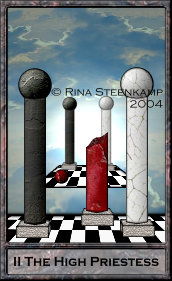
The tarot is a deck of 78 cards, and the earliest versions date from the Middle Ages. Over the years, people have been creating their own versions. Here's mine.
I became interested in the tarot when I was still in my teens, and my first set consisted of the major arcana (the 22 one-of-a-kind cards within the tarot deck that are supposed to have the deepest symbolic significance) drawn on the backs of my father's business cards. I made a first attempt to design my own deck when I was in my twenties, but I ran out of steam after five or six major arcana. Now, almost twenty years later, I guess it's time to give it another go.

(This is a rough draft that needs further research and editing.)
This card is all about polarity. In most versions you see the High Priestess, a veiled woman, standing between two pillars (often one black and one white) on a black-and-white floor. She's often seen holding the Torah or an other book of wisdom half-hidden in her sleeve - she possesses knowledge, but she doesn't offer it to the seeker. She's standing on the threshold between the pillars, blocking the way in, and you can't help wondering whether she's a helper or a guardian. One thing is certain - you need to pass her to proceed on your path.
My original version of this card showed the priestess standing in a gateway, in the middle of an empty landscape. This was partly inspired by an Ollie B. Bommel cartoon (Ollie is one of Hollands - and the worlds - finest cartoon characters) - where a gateway suddenly appears in the middle of a field. People walk around it and see nothing unusual, but when they pass through it they move into a different world.
Anyway, back to polarity. In one sense, in the western mystery tradition polarity is something that is being accepted and embraced - male and female, God and Goddess, life and death. In another sense, polarity is a consequence of the tragedy that lies at the heart of many, if not all, traditions. Within some traditions, it's the Fall from Grace. In others, it's a conscious act by God to manifest himself into the world and to separate the world from himself in order to know himself (or herself, or themselves, as the case may be and often is in western traditions).
To me, that's a very important aspect of the High Priestess. She knows of unity, yet she stands in a world that is steeped in polarity. She challenges the seeker to learn in order to proceed towards the One. As a symbol I chose the broken pillar from the Qabalah (and from freemasonry) - if only because my graphics skill are as yet limited and I don't know how to create believable human figures.
(I'm thinking of doing another version of the card that has, in stead of the checkered floor, a checkered path that trails off into the distance. That might be a better way to show that you have to pass between the columns in order to proceed.)
Here's another version, based on what I wrote yesterday. What I had in mind was to have a curved, checkered path trailing off into the distance. Unfortunately, with the graphics program that I'm using (Real-Draw) that would be a lot of work. It's not that hard to create a curved shape, but I would have to manipulate the black and white squares manually to have them follow the curve in stead of remaining arranged in straight lines, this isn't something that the program does automatically.

On this page Transitional HTML 4.01 and CSS 1 are used. If you're seeing this text you either have CSS switched off in your browser, or you're using a browser that can't handle CSS. If you're using an older browser version, you might want to consider upgrading.